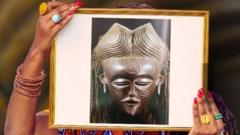An inspiring initiative, the Women’s History Museum of Zambia, seeks to challenge deep-seated myths about Africa's past, particularly regarding literacy and women's roles in society. Among the museum's highlighted artifacts is an inscribed wooden hunters' toolbox featuring Sona, an ancient and sophisticated writing system rarely utilized today. Co-founder Samba Yonga underscores the urgency of this endeavor: “We’ve grown up being told that Africans didn’t know how to read and write. But we had our own way of writing and transmitting knowledge that has been completely sidelined and overlooked,” she stated in a conversation with the BBC.
This project emerges as part of a broader online campaign aimed at emphasizing women's contributions to pre-colonial communities while striving to resurrect the cultural heritages that colonialism has nearly obliterated. Another remarkable artifact unveiled is a historically significant leather cloak, not seen in Zambia for over a century, representing a forgotten chapter in the culture of the Zambian people. "The artifacts signify a history that matters - a largely unknown history," Yonga added.
Through the Frame project, initiated in 2019 and further expanded via social media, the museum has shared 50 carefully documented objects, revealing that women were often central to the belief systems and understanding of the natural world within their societies. It challenges the lingering assumption that African cultures lacked their own knowledge systems by framing images of these artifacts, encouraging recognition of their historical significance.
Much of the collection was amassed during the colonial era, stored in foreign museums, including Sweden, which possesses approximately 650 Zambian cultural artifacts. Yonga’s unexpected discovery of these items during a trip to Stockholm in 2019 sparked her interest, leading to an exploration of their backgrounds and the communities they represent.
The meticulous craftsmanship of these artifacts, such as reed baskets, ceremonial masks, and leather cloaks made from antelope skin and adorned with geometric designs, reveals a culture rich in artistic expression and understanding. Yonga and her co-founder Mulenga Kapwepwe found that many traditional skills and knowledge linked to these items had been lost or forgotten within the Zambian communities.
A highlight of the Frame project has been the revival of interest in Sona, the intricate writing system used by the Chokwe, Luchazi, and Luvale peoples. This system involved geometric patterns etched in various media, conveying messages about community life, nature, and cosmology. With the help of community elders, Yonga has sought to preserve and propagate this knowledge, drawing attention to its relevance and keeping the historical narrative alive.
Yonga articulates the changing perception as remarkable, with many engaging positively with the posts about these artifacts. Furthermore, the museum recently unveiled how a seemingly simple grinding stone used by Tonga women served as a symbol of women's empowerment, transforming customary views on household items into poignant emblems of historical significance.
The Women’s History Museum of Zambia, established in 2016, aims to document women's roles in history and indigenous knowledge, while actively researching and curating an online archive of cultural artifacts. Yonga's transformative experience in rediscovering her cultural roots reflects a desire for others engaging with the Frame project to foster their own understanding of their historical, political, and social identities, revealing a vibrant past that continues to shape the present.






















